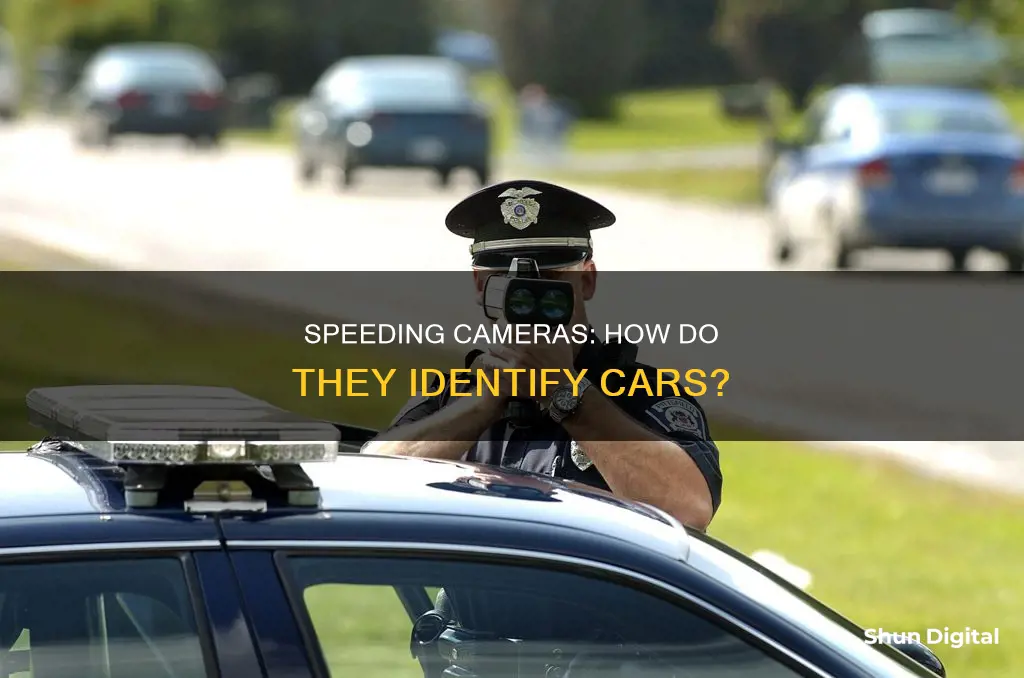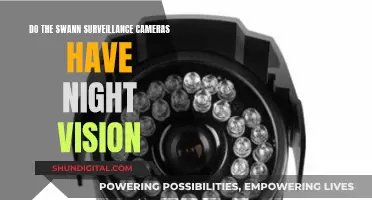
Speed cameras are electronic devices that detect the speed of vehicles using radar technology or detectors embedded in the road surface. If a vehicle is speeding, a digital image of the vehicle is recorded, including its type, colour, make, and number plate. This information is then compared to the registered owner of the car, who is issued an infringement notice. Speed cameras can monitor multiple lanes, and in the case of two vehicles driving past a speed camera at the same time, only the speeding vehicle will be recorded.
| Characteristics | Values |
|---|---|
| Camera type | Fixed, mobile, red-light, average speed |
| Technology | Radar, electronic detectors in the road surface |
| Vehicle detection | Speed, lane, type, colour, make, number plate |
| Image capture | Date, time, location, direction of travel, speed, speed limit, lane |
| Warning signs | 'Speed camera 24 hours', 'Speed camera ahead' and/or 'speed camera in use', 'Heavy fines loss of licence' |
What You'll Learn
- Multiple radar devices are used to monitor different lanes
- Cameras can be handheld or attached to a mobile police vehicle
- Detectors in the road's surface can be used to track vehicles
- Cameras can capture the colour, type, make, and number plate of a car
- Average speed cameras calculate average speed between two points

Multiple radar devices are used to monitor different lanes
The use of multiple radar devices allows for more accurate speed detection and helps to prevent errors. By having a dedicated radar device for each lane, the system can more effectively track the speed of multiple vehicles travelling in different lanes simultaneously. This setup also enables the system to capture multiple pictures of each vehicle, providing additional data points for speed calculation.
In some cases, older radar devices may only be capable of monitoring a single lane, but newer technology has introduced multistatic radar systems. These advanced systems can control up to six lanes of traffic simultaneously, offering a more comprehensive solution for speeding detection.
The implementation of multiple radar devices for lane monitoring is a crucial aspect of enforcing speed limits and ensuring road safety. It allows for accurate identification and recording of speeding vehicles, helping to deter speeding and reduce the incidence of crashes.
Understanding the Note 8 Camera's Unique Mode
You may want to see also

Cameras can be handheld or attached to a mobile police vehicle
Speed cameras are electronic devices that can detect the speed of vehicles using radar technology or detectors embedded in the road surface. If a vehicle is speeding, a digital image of the vehicle is recorded, including the type and number plate. Speed cameras can be fixed or mobile.
Mobile speed cameras are moveable devices, which can include handheld cameras used by police officers at the side of the road or cameras attached to a mobile police vehicle. They are effective because their unpredictability creates a general deterrence against speeding, leading to a crash reduction across the entire network, not just at camera locations.
Mobile speed cameras can be moved to different locations at different times, supporting the perception of 'anytime, anywhere' enforcement. They monitor multiple lanes and photograph vehicles exceeding the posted speed limit.
Like fixed speed cameras, mobile speed cameras are accompanied by warning signs. You will see signs coming up to and after mobile speed cameras, as well as a sign on top of the mobile speed camera vehicle when they are in operation, so you know your speed is being checked.
Reviving Lithium-Ion Camera Batteries: Simple Hacks for Photographers
You may want to see also

Detectors in the road's surface can be used to track vehicles
Detectors in the road surface can be used to track vehicles. These detectors are often used in conjunction with speed cameras to enforce speed limits and reduce crashes.
There are several types of detectors that can be placed in the road surface. Inductive loops are the most common type of detector technology. They consist of one or more turns of insulated loop wire wound in a shallow slot in the pavement. The size and shape of the loops can vary depending on the area to be detected, the types of vehicles to be detected, and the objective (e.g. speed measurements).
Another type of detector is the magnetometer, which measures changes in the horizontal and vertical components of the earth's magnetic field. Newer two-axis fluxgate magnetometers can operate near the equator, where older magnetometers could not. Magnetometers are useful on bridge decks and viaducts, where the steel support structure interferes with loop detectors.
Magnetic detectors consist of a coil of wire with a highly permeable core. They measure the change in the lines of flux of the earth's magnetic field and can only detect vehicles moving faster than a certain minimum speed.
When it comes to speed monitoring, inductive loops are often used in pairs, placed a certain distance apart. The loops should be large enough to sense high-body vehicles and provide a sharply defined wave front output as the vehicle passes over. Any time differences in the detection of different vehicle types should be minimised.
Other types of detectors that can be used for vehicle tracking include piezoelectric sensors, passive infrared sensors, Doppler and radar microwave sensors, and video image processors.
Troubleshooting Small Uploads of Raw Camera Files
You may want to see also

Cameras can capture the colour, type, make, and number plate of a car
Speed cameras are electronic devices that can detect the speed of vehicles using radar technology or detectors embedded in the road surface. If a vehicle is speeding, a digital image of the vehicle is recorded, including the type and number plate of the vehicle.
The cameras can capture the colour, type, make, and number plate of a car or vehicle. This information is then compared to the registered owner of the car to identify the likely driver. This person will then receive an infringement notice. However, they may not have been the person driving at the time.
The digital images also include other details such as the date and time, location of the camera, direction of travel, speed of the vehicle, the speed limit on that road, and the lane the vehicle was travelling in.
Speed cameras can monitor multiple lanes using radar technology or detectors placed in the road surface. They can detect and photograph a speeding vehicle even if it is behind other vehicles.
Transfer Mini DV Tapes to Computer: No Camera Needed
You may want to see also

Average speed cameras calculate average speed between two points
Average speed cameras are becoming more common as cars get faster and roads more congested. They are designed to be more effective at enforcing speed limits than traditional fixed cameras.
Average speed cameras calculate a car's speed between two points by recording its registration plate at an initial camera and then again at a second camera further down the road. The time taken for the car to pass between the two cameras is recorded and used to calculate its average speed. The minimum distance between the two cameras is 200 metres.
Average speed cameras are often mounted on top of long yellow poles at the side of the road, with one camera monitoring each lane of traffic. They are typically found on dual carriageways, motorways, A roads, and in urban areas. They are also used in roadwork zones where the speed limit has been lowered.
If a driver is caught speeding by an average speed camera, they will receive a penalty such as a fine, penalty points on their licence, or having to attend a speed awareness course.
Testing Your Camera's Lithium Battery: A Simple Guide
You may want to see also
Frequently asked questions
Speed cameras use radar technology or detectors embedded in the road to measure the speed of vehicles. If a vehicle is speeding, a digital image is recorded, including the type, colour, make, and number plate of the vehicle.
Each speeding camera has multiple radar devices, with each device aimed at a different lane. When a car goes faster than the speed limit, a picture is taken, and the radar device that recorded the speed is noted.
The camera can tell which car was speeding as it has multiple radar devices aimed at different lanes.
A speeding vehicle can be detected and photographed even if it's behind other vehicles.
The information is compared to the registered owner of the car to identify the likely driver, and this person will receive an infringement notice. They may or may not be the person who was driving at the time.







